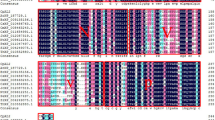Abstract
Based on the DNA sequence of ACS9, two produced fragments were subcloned into binary vector pCAMBIA1300 in antisense and sense orientations, and the generated RNA interference (RNAi) vector was then transformed into Arabidopsis thaliana. The stress resistance function of ACS9 gene in Arabidopsis thaliana was researched by determination of stress resistance physiologic indexes, NaCl and PEG6000 resistance. The results showed that the inhibition of ACS9 expression enhanced the sensitivity to high concentration NaCl (150 mmol/L) and PEG6000 (7%) in Arabidopsis thaliana seeding stage. The proline contents and water loss rates in transgenic plants were 0.68 and 1.4 times higher than those in the wild-type leaves, respectively, indicating that the inhibition of ACS9 expression due to salt and drought resistant was reduced and suggested that ACS9 gene played important roles in plant salt and drought tolerance.
Similar content being viewed by others
References
Abeles F B, Morgan P W, Saltveit M E Jr (1992). Ethylene in plant biology. New York: Academic Press, Inc
Adams D O, Yang S F (1979). Ethylene biosynthesis: Identification of 1-aminocyclopropane-1-carboxylic acid as an intermediate in the conversion of methionine to ethylene. Proc Natl Acad Sci USA, 76(1): 170–174
Alonso J M, Stepanova A N (2004). The ethylene signaling pathway. Science, 306(5701): 1513–1515
Bates L S, Waldren R P, Teare I D (1973). Rapid determination of free proline for water-strress studies. Plant and Soil, 39(1): 205–207
Bleecker A B, Kende H (2000). Ethylene: a gaseous signal molecule in plants. Annu Rev Cell Dev Biol, 16(1): 1–18
Boller T, Herner R C, Kende H (1979). Assay for and enzymatic formation of an ethylene precursor, 1-aminocyclopropane-1-carboxylic acid. Planta, 145(3): 293–303
Chen Y F, Etheridge N, Schaller G E (2005). Ethylene signal transduction. Annals of Botany, 95(6): 901–915
Chen Z Z, Hong X H, Zhang H R, Wang Y Q, Li X, Zhu J K, Gong Z Z (2005). Disruption of the cellulose synthasegene, AtCesA8/IRX1, enhances drought and osmotic stress tolerance in Arabidopsis. The Plant J, 43: 273–283
Chuang C F, Meyerowitz E M (2000). Specific and heritable genetic interference by double-stranded RNA in Arabidopsis thaliana. Proc Natl Acad Sci USA, 97(9): 4985–4990
Clarke J M, Mccaig T N (1982). Evaluation of techniques for screening for drought resistance in wheat. Crop Sci, 22: 503–506
Clough S J, Bent A F (1998). Floral dip: a simplified method for Agrobacterium-mediated transformation of Arabidopsis thaliana. Plant J, 16(6): 735–743
Cornelius S B, James J G (2006). Ripening in the tomato Green-ripe mutant is inhibited by ectopic expression of a protein that disrupts ethylene signaling. PNAS, 103(20): 7923–7928
Ferrari S, Vairo D, Ausubel F M, Cervone F, Lorenzo D G (2003). Tandemly duplicated Arabidopsis genes that encode polygalacturonase-inhibiting proteins are regulated coordinately by different signal transduction pathways in response to fungal infection. Plant Cell, 15(1): 93–106
Ge L, Liu J Z, Wong W S, Hsiao W L W, Chong K, Xu Z K, Yang S F, Kung S D, Li N (2000). Identication of a novel multiple environmental factor-responsive 1-aminocyclopropane-1-carboxylate synthase gene, NT-ACS2, from tobacco. Plant Cell Environ, 23(11): 169–182
Gómez-Cadenas A, Tadeo F R, Primo-Millo E, Talon M (1998). Involvement of abscisic acid and ethylene in the responses of citrus seedlings to salt shock. Physiologia Plantarum, 103(4): 475–484
Liu D, Li N, Dube S, Kalinski A, Herman E, Mattoo A K (1993). Molecular characterization of a rapidly and transiently wound-induced soybean (Glycine max L.) gene encoding 1-aminocyclopropane-1-carboxylate synthase. Plant and Cell Physiol, 34: 1151–1157
O’Donnell P J, Calvert C, Atzorn R, Wasternack C, Leyser H M O, Bowles D J (1996). Ethylene as a signal mediating the wound response of tomato plants. Science, 274(5294): 1914–1917
Pan Y G (2009). Functional confirmation and promoter activity of Phytophthora infestans-defense related ACS9 gene in Arabidopsis. Dissertation for the Master Degree. Baoding: Agricultural University of Hebei, 38–39 (in Chinese)
Peng H P, Lin T Y, Wang N N, Shih M C (2005). Differential expression of genes encoding 1-aminocyclopropane-1-carboxylate synthase in Arabidopsis during hypoxia. Plant Mol Biol, 58(1): 15–25
Pierik R, Sasidharan R, Voesenek L A C J (2007). Growth control by ethylene: Adjusting pheno types to the environment. Plant Growth Regul, 26(2): 188–200
Pierik R, Tholen D, Poorter H, Visser E J, Voesenek L A C J (2006). The Janus face of ethylene: growth inhibition and stimulation. Trends in Plant Sci, 11(4): 176–183
Smith N A, Singh S P, Wang M B, Stoutjesdijk P A, Green A G, Waterhouse P M (2000). Total silencing by intron-spliced hairpin RNAs. Nature, 407(6802): 319–320
Straeten D V, Wiemeersch V L, Goodman H M, Montagu M V (1990). Cloning and sequence of two different cDNAs encoding 1-aminocyclopropane-1-carboxylate synthase in tomato. Proc Natl Acad Sci USA, 87(12): 4859–4863
Tsuchisaka A, Guixia Yu, Hailing **, Alonso J M, Ecker J R, **aoming Zhang, Shang Gao, Theologis A (2009). A combinatorial interplay among the 1-aminocyclopropane-1-carboxylate isoforms regulates ethylene biosynthesis in Arabidopsis thaliana. Genetics, 183(3): 979–1003
Tsuchisaka A, Theologis A (2004). Unique and overlap** expression patterns among the Arabidopsis 1-amino-cyclopropane-1-carboxylate synthase gene family members. Plant Physiol, 136(2): 2982–3000
Wang N N, Shih M C, Li N (2005). The GUS reporter-aided analysis of the promoter activities of Arabidopsis ACC synthase genes AtACS4, AtACS5, and AtACS7 induced by hormones and stresses. Journal of Experimental Botany, 56(413): 909–920
Weigel D, Glazebrook J (2004). Arabidopsis: A Laboratory Manual. Bei**g: Chinese Industry Press, 165–166
Yamagami T, Tsuchisaka A, Yamada K, Haddon W F, Harden L A, Theologis A (2003). Biochemical diversity among the 1-aminocyclopropane-1-carboxylate synthase isozymes encoded by the Arabidopsis gene family. J Biol Chem, 278(49): 49102–49112
Yang S F, Hoffman N E (1984). Ethylene biosynthesis and its regulation in higher plants. Annu Rev Plant Physiol, 35(1): 155–189
Author information
Authors and Affiliations
Corresponding authors
About this article
Cite this article
Han, X., Pan, Y., Liu, Y. et al. Knockdown of ACS9 expression in Arabidopsis decreases the tolerance to salt and osmotic stress. Front. Agric. China 5, 181–186 (2011). https://doi.org/10.1007/s11703-011-1022-5
Received:
Accepted:
Published:
Issue Date:
DOI: https://doi.org/10.1007/s11703-011-1022-5




